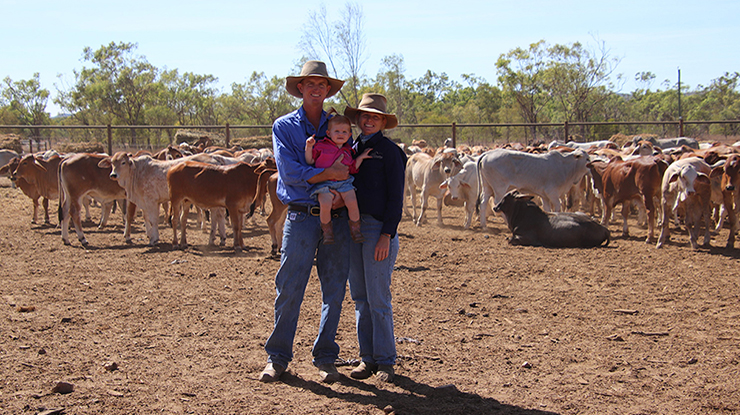 Dan and Georgia Slaney with daughter Gabrielle, at ‘Amber Station’.
Dan and Georgia Slaney with daughter Gabrielle, at ‘Amber Station’.
No surprise that year round P drives productivity
Queensland cattle breeding operation ‘Amber Station’ is an example of how year-round phosphorus (P) supplementation, along with property-wide herd and infrastructure improvements, can deliver significant productivity benefits.
The 104,000ha Mount Surprise property was purchased by Werrington Cattle Company in 2019. Since then, managers Georgia and Dan Slaney have improved the productivity and health of the existing P-deficient herd.
Overcoming the challenge of accessing the property during the wet season was a major factor in their successful P strategy.
Turning the tables
The Slaneys tackled the herd’s P deficiency by feeding bulka bags of both wet and dry season supplement side-by-side – a strategy used on other Werrington Cattle Company properties with success.
Dan recalled how 2,000 breeders consumed 22t of P supplement in three weeks, a rate he had never previously witnessed.
The cattle quickly recovered condition and within a few weeks had significantly reduced their supplement intake.
Infrastructure key
Investment in yards, fences and water has further improved carrying capacity and overall efficiency at Amber Station.
Additional fencing has allowed pasture spelling, reduced grazing pressure, and supported herd expansion from 2,000 breeders in 2019 to 3,600 breeders at present.
Total stock numbers, including breeders, joiner heifers and weaner heifers, increased from 3,300 in 2019 to 6,100 in 2023.
Road upgrades have improved access for more of the year.
An economic analysis conducted in 2020 indicated the expected return on the total funds invested in the property purchase, livestock, plant and equipment, and property development over the first decade could average 4–5%/year using long-term cattle prices and costs.
Overcoming access issues
Dan and Georgia use bulka bags to give cattle access to enough P to get them through the wet season – they also feed P year round, and have various recipes depending on seasonal variations.
“Cattle are less likely to gorge wet season P when they’re fed dry season supplements with P in the months leading up to the wet season,” Georgia said.
“It means they’re getting a steadier but adequate supplement intake over the growing season.”
Dan emphasised that providing P supplement year-round allowed cattle to self-regulate their intake.
The strategy is two-fold:
- Prior to the wet season starting: 250kg or 400kg bags are placed across paddocks, for wider distribution of supplement when cattle are scattered due to surface water. Dan puts out about six months’ worth of the wet season mix before the wet commences and aims to have it all out by November.
- During the wet season: when vehicle access is limited during the wet season Dan has on a few occasions transported 25kg bags by helicopter to replenish existing supplement sites.
Georgia and Dan include 5% lime in the mix so a surface crust forms to weatherproof the recipe. Dan said the quality of P is important.
“It makes a big difference in terms of actual absorption into the bloodstream and the palatability of the lick.”
P program
Table 1 outlines Amber Station’s wet season supplementation approach.
Table 1: The 'Amber Station' wet season lick recipe
| Ingredient | Inclusion rate |
| GranAm™ | 12% |
| Kynofos 21 | 48% |
| Lime | 5% |
| Rumigro | 0.5% |
| Salt | 34.5% |
Key aspects of their year-round supplementation program include:
- dry season urea-based supplements include approximately 10–15% Kynofos 21 which will supply around 3g of P/ head/day to heifers and 5g of P/head/ day to breeders during the dry season
- 10g of P/day for each cow-calf unit during wet season and targeted dry season supplementation (with P) for weaners and replacement heifers
- GranAm™ helps fill the protein gap as pasture quality declines later in the wet season.
Dan and Georgia have seen significant benefits from this supplementation approach, including:
- increased weaning rates – from the initial 47% to 66% in 2020 (see Table 2), and further to 83% in 2022
- reduced breeder mortality – from 8% to 2%
- improved female and steer cattle weights and value.
The overall contribution of P supplementation to the predicted increase in gross margin/adult equivalent on Amber is significant (Table 2).
Table 2: A comparison of the business before and after the property's five-year development plan was implemented
| Amber Station | Before P | Since P |
| Total adult equivalents | 5,200 | 8,742 |
| Total cattle carried | 6,196 | 8,259 |
| Total breeders mated and kept | 4,158 | 4,860 |
| Total calves weaned | 2,012 | 3,945 |
| Weaners/total cows mated | 47% | 66% |
| Overall breeder deaths | 8% | 2% |
| Female sales/total sales | 34% | 48% |
| Total cows and heifers sold | 519 | 1,810 |
| Total steers sold | 1,006 | 1,972 |
| Average female price | $696 | $774 |
| Average steer price | $366 | $428 |
| Direct costs excluding bulls | $104,307 | $475,747 |
| Bull replacement | $78,359 | $96,842 |
| GM per adult equivalent | $105 | $191 |
Since this analysis was done in 2020, Dan has seen ongoing improvements.
In recent times, Dan and Georgia have increased P levels in the lick and keep a close eye on their supplementation program to ensure effective results. Their current wet season mix recipe is 60% phosphorus.
“I’m always monitoring and trying to improve the lick,” Dan said. “Supplementation is one of our largest direct costs so it’s something I keep a real watch on to make sure we get a good return on investment.”



